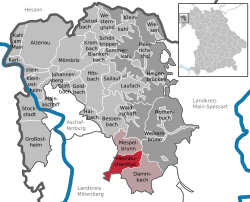Heimbuchenthal
| Heimbuchenthal | ||
|---|---|---|
| ||
 Heimbuchenthal | ||
Location of Heimbuchenthal within Aschaffenburg district  | ||
| Coordinates: 49°53′N 9°18′E / 49.883°N 9.300°ECoordinates: 49°53′N 9°18′E / 49.883°N 9.300°E | ||
| Country | Germany | |
| State | Bavaria | |
| Admin. region | Unterfranken | |
| District | Aschaffenburg | |
| Municipal assoc. | Mespelbrunn | |
| Government | ||
| • Mayor | Rüdiger Stenger (SPD/FWG) | |
| Area | ||
| • Total | 17.15 km2 (6.62 sq mi) | |
| Population (2015-12-31)[1] | ||
| • Total | 2,204 | |
| • Density | 130/km2 (330/sq mi) | |
| Time zone | CET/CEST (UTC+1/+2) | |
| Postal codes | 63872, 63874 (Höllhammer) | |
| Dialling codes | 06092 | |
| Vehicle registration | AB, ALZ | |
| Website | www.heimbuchenthal.de | |
Heimbuchenthal is a community in the Aschaffenburg district in the Regierungsbezirk of Lower Franconia (Unterfranken) in Bavaria, Germany, and the seat of the Verwaltungsgemeinschaft (Administrative Community) of Mespelbrunn. It is also a state-recognized recreational resort (Erholungsort).
Geography
Location
Heimbuchenthal lies in the Bavarian Lower Main (Bayerischer Untermain) in the upper Elsava valley in the Spessart Nature Park (Naturpark Spessart).
History
In 1282, Heimbuchenthal, whose name comes from the hornbeams (Hainbuchen in German), had its first documentary mention. In 1495, the place was first named as a court centre. Along with the Archbishopric of Mainz, the former Vogteiamt (until 1782) passed at Secularization to the newly formed Principality of Aschaffenburg, with which it passed in 1814 (by this time it had become a department of the Grand Duchy of Frankfurt) to Bavaria.
In 1982, there was a 700-year jubilee celebration, in the framework of which a few tourist attractions were dedicated.
Demographics
Within the municipal area there were 1,875 inhabitants in 1970, 2,106 in 1987, 2,260 in 2000 and 2,154 in 2013
Economy
According to official statistics, there were 133 workers on the social welfare contribution rolls working in producing businesses in 1998. In trade and transport this was 27. In other areas, 176 workers on the social welfare contribution rolls are employed, and 808 such workers work from home. There are two processing businesses. Three businesses are in construction, and furthermore, in 1999, there were 4 agricultural operations with a working area of 29 ha.
Municipal tax revenue in 1999 amounted to €1,211,000 (converted), of which business taxes (net) amounted to €287,000.
Attractions
Heimathenhof
One kilometre west of the community is found the Heimathenhof, a former estate converted to a hotel and an inn. Right at the estate, red and fallow deer can be seen in a broad enclosure.
Höllhammer
Some 4 km southwards in the Elsava valley lies the Höllhammer pond with a former hammerworks. First mentioned in the late 13th century was a hunting lodge called Mulen, along with a forester’s seat, a Forsthube.[2] In 1535, the lordly building was already in ruins and the Counts of Ingelheim, who already had their seat at nearby Mespelbrunn Castle, then had an estate built there, which was named Höllenhof after the nearby Höllschlucht (a gorge).
About 1700 came the first hammerworks, driven by a mill, which took its name, Höllhammer, from the estate. The hammerworks, which in 1795 had been taken over by Georg Ludwig Rexroth, was said in the early 19th century to be “the first and most productive hammerworks” in the Principality of Aschaffenburg.[3] About 1830 some 100 people lived at the Höllhammer and the specially built school was attended by up to 30 children. Until 1891, production continued. Thereafter the lands were converted into an estate. Still to be seen are the farmhands’ house with the belltower, the lord’s house and the school. The buildings are all used as dwellings, even the old smithies. In the woods is found the Rexroth family’s old graveyard.
Today, the Höllhammer is private property and not accessible to the public.
Others
Fahrradmuseum Pedalwelt – modern bicycle development and drive concepts from all over the world (with test course).
Government
Community council
The council is made up of 15 council members, counting the mayor.
| CSU/Bürgervereinigung | SPD/FWG | Total | |
| 2008 | 7 | 8 | 15 seats |
| (as at municipal election held on 2 March 2008) | |||
Mayor
The mayor is Rüdiger Stenger (SPD/FWG).
Town twinning
-
 Thury-Harcourt, Calvados, France since 1988
Thury-Harcourt, Calvados, France since 1988
Coat of arms
The community’s arms might be described thus: Gules a fess wavy argent, in chief three beech leaves of the first, two in saltire surmounted by the third palewise, issuant from the base a cogwheel spoked of five of the first.
The German blazon does not mention the cogwheel’s spokes.
The beech leaves in the arms refer to the geographical location in the High Spessart and are canting for the community’s name (Buchen is German for “beeches”). The wavy fess (horizontal band) symbolizes the community’s location in the Elsava valley. The combination of the wavy fess and the cogwheel refers to the hammerworks that was running in the 18th and 19th centuries in the outlying centre of Höllhammer. The tinctures gules and argent (red and silver) are those also seen in the Electoral Mainz coat of arms, Mainz having held the local lordship until 1803. The Electoral Mainz Amt in the community comprised eight places and gave it a certain autonomy.
The arms have been borne since September 1981.
Education
The following institutions can be found in Heimbuchenthal (as at 2006):
- Kindergartens: 75 kindergarten places with 68 children
- Elementary schools: 1 with 15 teachers and 201 pupils
References
External links
| Wikimedia Commons has media related to Heimbuchenthal. |
